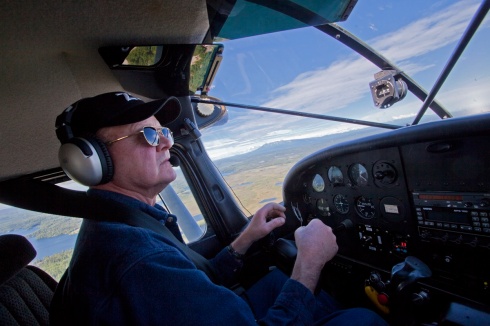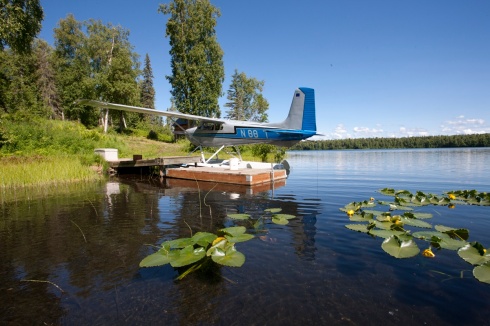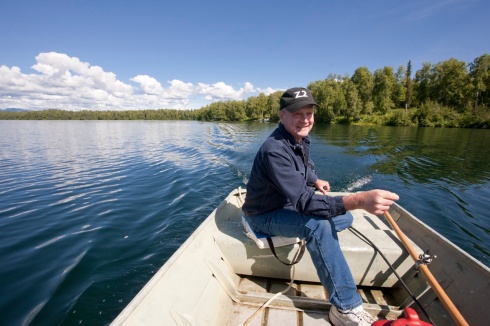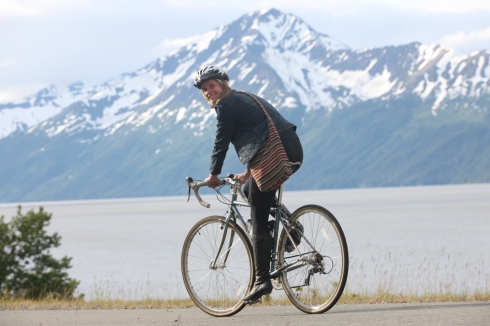
When we sent emails to Iowa State alumni in Alaska way back in February, one of the first responses I received was from someone named Grumpy who wrote this: “Would you like a floatplane ride while in the Anchorage area? I should be available.”
Well, heck yes.
“Grumpy” turned out to be Darrell Holmstrom, ’74 aerospace engineering. Darrell is a veteran commercial pilot for Federal Express who also happens to fly his own floatplane and two helicopters. We met him July 6 at his floatplane in Eagle River, Alaska, not far from his home in Chugiak.
Let the fun begin!
Jim and I climb into the four-seat plane (no easy task; I require a push from behind) and off we go.
Our first view is of Knik Arm at high tide, with the towns of Palmer and Wasilla off to our right. Soon we can see the town of Willow, the starting point for the Iditarod Trail Dog Sled Race. As we fly, Darrell points out the Iditarod Trail, which in summer is a river. In winter, Alaskans use the frozen river like a highway to travel by snowmobile.
Next he shows us Mt. McKinley (also known as Denali), the highest mountain peak in North American with an elevation of 20,320 feet, which on this day is partially obscured by clouds.

We see fishing lodges, lakes, a glacier, Mt. Susitna (“The Sleeping Lady”), rivers made from glacial silt. But no roads. I realize you don’t know what Alaska really looks like until you fly over it.
I’m in the back seat; Jim is in the front with Darrell. I’m happy that I remembered to take Dramamine and wear my motion-sickness bracelet. But I’m not afraid.
“Floatplanes are the safest thing up here,” Darrell says. “You can land almost anywhere.”

Where we do land is a lake near which he has a cabin. The day is sunny and warm. We extricate ourselves from the plane and walk up the hill to the cabin, passing by a few outbuildings.
“One more building and I’ll have a compound,” Darrell says.
We sit on his porch, swatting mosquitoes and talking about Alaska.
Darrell was in the Air Force, stationed in Fairbanks from 1982 until 1985. After he left the military he was hired by Eastern Airlines, then a cargo outfit called Flying Tiger. He moved to his current location in 1988 just as Fed Ex bought Flying Tiger, and he’s been flying for them ever since – to Asia, Australia, Hawaii, and even “down to America.”
He likes the Alaskan attitude. “It’s kind of like Texas: ‘Leave us alone. Don’t mess with us,’” he says. He likes to hunt and fish, restore projects “that people gave up on” (like the helicopters), and work on the cabin. “The trick is to get everything built before you get too old,” he says.
Up here, he explains, a small airplane is “like an Alaskan pickup truck.” You need it to get where you’re going. You can haul stuff in it. The floats on Darrell’s plane can be removed during the winter and replaced with skis for snowy landings.
The sun is so warm it’s almost hot. Darrell says that compared to Anchorage it gets warmer here on the lake, but it also gets colder here in the winter. But it’s not as bad as Fairbanks, he says, which can drop to 40 or 50 degrees below zero in the winter.

We leave Darrell’s sunny porch and take his small motorboat across the lake to visit one of his friends who is building a new cabin. It’s a marvelous place, and I can see myself living here all summer. Except I can’t swim. So maybe the lake is not the best place for me.
One more quick visit to the cabin (indoor plumbing! a fully stocked kitchen!) before we board the plane and head back to Eagle River. I get to sit in the front seat this time. The views are amazing.
I have to ask Darrell one more thing: Why “Grumpy?”
“It’s an Internet name,” he says. “My wife came up with it.”










